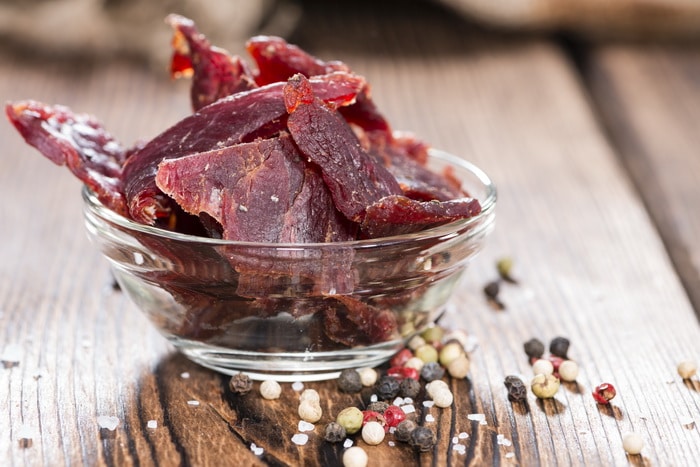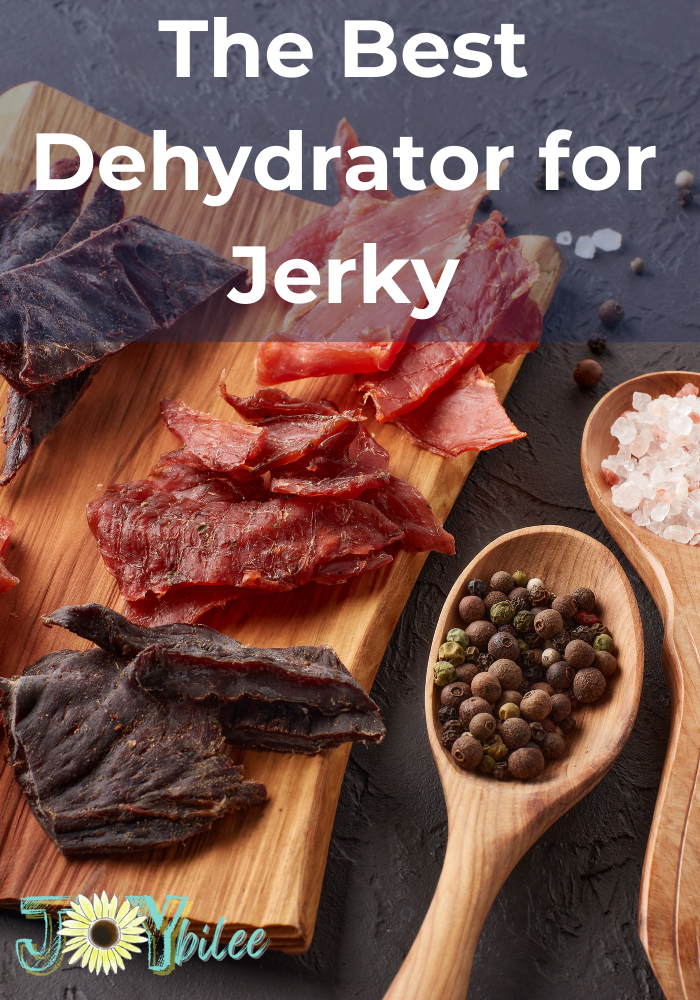Fruits and vegetables are simple to dehydrate. Meat needs a higher temperature than most fruits and veggies, so if you want to make jerky or other dried meats, choosing a good dehydrator for jerky is a must.
Here at Joybilee Farm, we’ve been dehydrating as a food preservation method for over 30 years. Working largely with garden produce, berries, fruits, and a few yearly batches of crisp, tasty, jerky. Jerky making is a bit more labor intensive than dehydrating fruits and vegetables. But, it’s one of a few ways to safely and effectively dry meat, that’s shelf stable and doesn’t require constant refrigeration.
Of course, a dehydrator is a versatile workhorse for food preservation. You can use it for fruit leather, fruit rolls, dried fruit, dehydrated vegetables, and of course for jerky.
Choosing a Dehydrator for Jerky:
Dehydrators are available both new and second hand. The new models can be as low as 100$ to several hundred or a thousand. A more expensive dehydrator does not necessarily equal a better dehydrator. The pricier dehydrators are more likely to be industrial sized, take up a lot of space, and possibly have more stainless steel components for easier sanitizing in a commercial setting. The best dehydrator for jerky is simply one that can reach 165F and maintain that temperature for the drying cycle.
Second hand dehydrators are sometimes available through ads, social media, or from friends. If you want to use a second hand dehydrator for jerky, or to test if your current dehydrator will work, you can do so with a temperature gauge like what’s used for BBQ meat temperature checking.
Simply place the temperature probe inside the dehydrator, and run it for 30 minutes to 60 minutes. If the temperature reading is accurate to the temperature set, you should be good to dehydrate jerky. For peace of mind, check on at least 3 different levels in the dehydrator, and at the center and edges of a round style dehydrator, or front and back of a frontal access dehydrator.
Trays in home dehydrators are often now silicon mesh with heavier plastic framing supports. They are dishwasher safe, and fairly easy to clean. Round dehydrator trays can be less easy to clean than square.
The fan should circulate air evenly to all trays. Many dehydrator models now include timers and auto programing for temperature. You can get a moisture monitor to help determine the actual residual moisture content of food too. Some dehydrators let you set up recipes with time and temperature, including two different temperature settings for convenience.
Older model dehydrators may have issues with temperature control, this is why it’s important to test the temperature holding of an older model dehydrator before using it for jerky. An older model dehydrator that no longer has a high heat output from it’s heating element can still be used for food dehydration, especially green herbs and leafy greens. Just don’t use it as a dehydrator for jerky as it’s adjustable thermostat may no longer be functional. As an example, my 30+ year old Beron dehydrator no longer generates enough heat for jerky, but does still work for greens, so it’s my back up wild harvesting dehydrator rather than the workhorse it used to be.
If you want to make jerky and don’t have a dehydrator that will go to a high enough temperature, you can use your oven to bring the meat to the right temperature and to a half dry state, then transfer it to the dehydrator to finish. If doing that, use a meat thermometer to make sure the interior of the jerky gets to the right temperature in the oven.

Jerky Basics:
Jerky can be made from any lean meat, however beef jerky is a fairly standard type. Other snacks can be made with other cuts of lean meat, including some lean ground meats. Flank steak, or an inexpensive roast, is often the preferred raw meat for making jerky.
Here are a few recipes for jerky using the traditional vinegar, and even non-traditional kombucha. Liquid smoke is often added to jerky as flavor, but spices like smoked paprika can also help with the slight smoke flavored aspect. Depending on the recipe, you can vary the level of salt used in your dehydrated jerky.
During the drying process monitor the trays to make sure the airflow is adequate. Most new dehydrators don’t require tray rotation during the dehydrating process, but some older dehydrator models might.
Here’s another of our jerky recipes, for your enjoyment. Jerky marinaded meat can also be preserved in a freeze dryer, but will not have the traditional jerky texture.
Depending on when you finish the jerky prep, you may wonder if it is safe to run a dehydrator overnight. Yes, our programmable dehydrators are safe to run overnight, and can even be set to stop at the recipe’s ideal time. Even if that’s 2am. However, many dehydrators do beep when the drying time is completed, so setting it for a few extra hours to time it to morning alarms might be a good plan too.

Dehydrator Storage:
I use my dehydrator throughout the year, so it sits on a low shelving unit alongside the kitchen. I have a ten tray Excalibur unit, but a smaller unite like a five or six tray model, can fit comfortably on a kitchen counter. When not in use, a small unite can be stored in a cupboard until needed. I like the ten tray Excalibur as it is divided into two zones, so I don’t have to fill the entire 18 square feet of drying space to run an energy efficient dehydrator set. While this is a premium dehydrator, smaller ones will work just as effectively, if not more effectively.
The Corsori 6 tray dehydrator is one small dehydrator that does have stainless steel racks, great air circulation, and works great as a jerky dehydrator. It is a personal favorite and the best of my dehydrators for jerky. It fits on a countertop or the top of a small shelving unit.
For storing your dehydrated food, check out the top three ways to store dehydrated food, that improve shelf stability.
Wash your dehydrator trays regularly. I prefer washing mine immediately after drying meat, or anything sticky. Greens, herbs, and non-sticky vegetables can get a few batches done before the trays need washing. The more commercial style dehydrators have stainless steel trays that can handle a sanitizer, most home dehydrators have dishwasher-safe trays for easy cleanup.
Cleaning your dehydrator drip trays, and drying trays after running jerky is essential to prevent the potential of bacteria build up. As well as remove any chance of cross contamination between meat and either fruits or vegetables in the drying process.
There are many accessories available for dehydrators, one that I’d recommend is a silicon dehydrator sheet. It is sometimes called a fruit roll sheet, as it helps keep semi-liquid preparations like apple sauce safely on the dehydrator trays for making fruit leather. It also helps keep small pieces of food, like small cherry tomatoes or grapes, from falling through the gapes of the dehydrator trays after the food is dry. The tray liners are not necessary when making jerky, as the meat will dry best directly on the tray, but it is a useful accessory if you’re working with other food types.

Dive into dehydrating food:
If you’ve never dehydrated food before, you can start this year. Nearly any fruit or vegetable can be dehydrated. Dehydration is one of the most accessible methods of food preservation, and you don’t even need a dehydrator to get started. You can even dehydrate meat and full meals.
-
- What’s dehydrating, anyway?—Learn the basics of how dehydrating works, and the essential tips and tools you need to get started with your dehydrator.
- Dehydrating from A to Z—Discover how to properly dehydrate fruits and veggies, meat and fish, and even herbs and spices.
- Meals, snacks, and sides—Put your newfound knowledge to the test with recipes for classic dried foods like Kale Chips and Apple Leather, and full meals like Shepherd’s Pie and Curry Chicken with Rice.
- Pro-tips on food preparation, rehydration, and using your dehydrated food to boost flavor and nutrition.
Start drying your own food today with the Dehydrator Cookbook for Beginners.





Leave a Reply